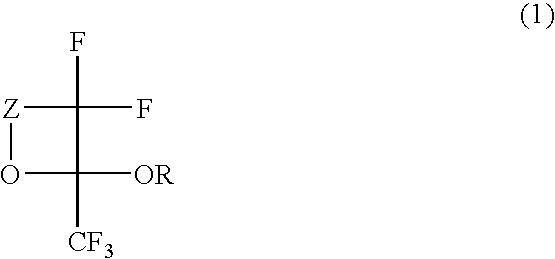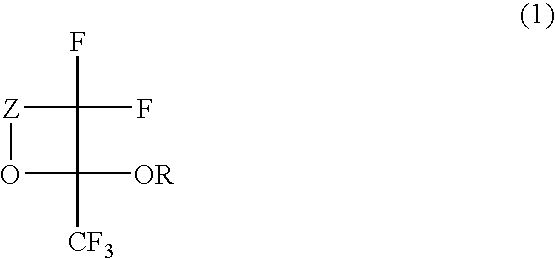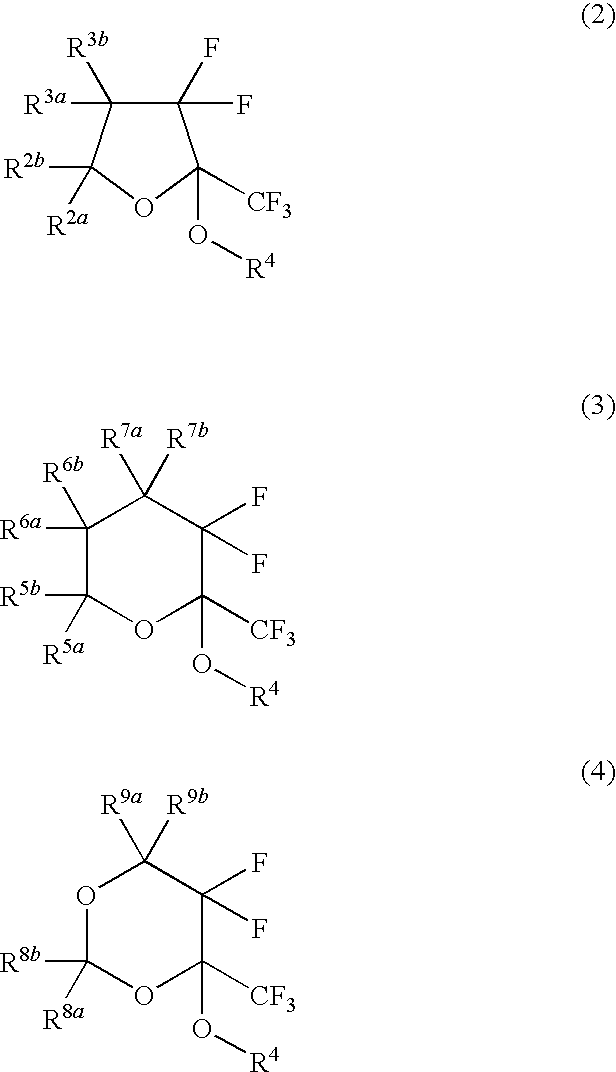Fluorinated monomer of cyclic acetal structure, polymer, resist protective coating composition, resist composition, and patterning process
a technology of cyclic acetal and fluorinated monomers, applied in the field of fluorin, can solve the problems of resist performance, pattern profile change, postponement of fsub>2 /sub>lithography, etc., and achieve the effects of high radiation resistance, easy handling, and convenient us
- Summary
- Abstract
- Description
- Claims
- Application Information
AI Technical Summary
Benefits of technology
Problems solved by technology
Method used
Image
Examples
example 1
[0403]Synthesis of Monomer 1
[0404]
[0405]While a mixture of 50.0 g of Hemiacetal-1, 40.8 g of pyridine, and 100 g of acetonitrile was stirred under ice cooling in a nitrogen atmosphere, 22.0 g of isobutyric acid chloride was added dropwise over 30 minutes. After 30 minutes, the reaction solution was diluted by adding 100 g of hexane, and 400 g of water was then added to the reaction solution, which was stirred for 30 minutes to quench the reaction and decompose the excess reactants. After ordinary aqueous work-up, the reaction product was purified by vacuum distillation, obtaining 60.8 g of the target compound (yield 98%). Colorless liquid, boiling point 63-67° C. / 13 Pa. On NMR analysis, it was a mixture of diastereomers in a molar ratio 67:33.
[0406]IR (thin film): ν=2981, 2940, 2883, 1774, 1727, 1639, 1471, 1452, 1388, 1336, 1303, 1282, 1218, 1155, 1112, 1081, 1039, 1004, 939, 927 cm−1
[0407]1H-NMR (300 MHz in DMSO-d6) of mixture of 67:33 (mole) diastereomers: δ=1.11 (0.99H, d, J=6....
example 2
[0409]Synthesis of Monomer 2
[0410]
[0411]A mixture of 32.0 g of Hemiacetal-2, 28.4 g of methyl iodide, 27.8 g of silver(I) oxide, and 150 g of ethyl acetate was stirred at 40° C. for 24 hours. After the insoluble was filtered off, the reaction mixture was vacuum concentrated and purified by silica gel column chromatography, obtaining 27.1 g of the target compound (yield 81%).
example 3
[0412]Synthesis of Monomer 3
[0413]
[0414]To a mixture of 40.8 g of Hemiacetal-3, 15.2 g of triethylamine, 1.5 g of sodium iodide, and 200 g of acetonitrile was added 10.5 g of chloromethyl methyl ether. The mixture was stirred at 50° C. for 16 hours. After ordinary aqueous work-up, the reaction product was purified by silica gel column chromatography, obtaining 43.0 g of the target compound (yield 95%).
PUM
| Property | Measurement | Unit |
|---|---|---|
| wavelength | aaaaa | aaaaa |
| size | aaaaa | aaaaa |
| refractive index | aaaaa | aaaaa |
Abstract
Description
Claims
Application Information
 Login to View More
Login to View More - R&D
- Intellectual Property
- Life Sciences
- Materials
- Tech Scout
- Unparalleled Data Quality
- Higher Quality Content
- 60% Fewer Hallucinations
Browse by: Latest US Patents, China's latest patents, Technical Efficacy Thesaurus, Application Domain, Technology Topic, Popular Technical Reports.
© 2025 PatSnap. All rights reserved.Legal|Privacy policy|Modern Slavery Act Transparency Statement|Sitemap|About US| Contact US: help@patsnap.com



